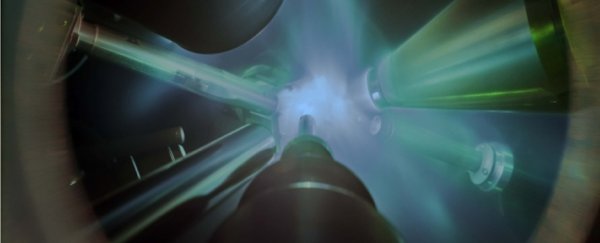It has taken one of the most powerful lasers on the planet, but scientists have done it. They've confirmed the existence of 'superionic' hot ice - frozen water that can remain solid at thousands of degrees of heat.
This bizarre form of ice is possible because of tremendous pressure, and the findings of the experiment could shed light on the interior structure of giant ice planets such as Uranus and Neptune.
On Earth's surface, the boiling and freezing points of water vary only a little - generally boiling when it's very hot, and freezing when it's cold. But both these state changes are at the whim of pressure (that's why the boiling point of water is lower at higher altitudes).
In the vacuum of space, water can't exist in its liquid form. It immediately boils and vaporises even at -270 degrees Celsius - the average temperature of the Universe - before desublimating into ice crystals.
But it's been theorised that in extremely high-pressure environments, the opposite occurs: the water solidifies, even at extremely high temperatures. Scientists at Lawrence Livermore National Laboratory directly observed this for the first time just recently, detailed in a paper last year.
They created Ice VII, which is the crystalline form of ice above 30,000 times Earth's atmospheric pressure, or 3 gigapascals, and blasted it with lasers. The resulting ice had a conductive flow of ions, rather than electrons, which is why it's called superionic ice.
Now they've confirmed it with follow-up experiments. They have proposed the new form be named Ice XVIII.
In the previous experiment, the team had only been able to observe general properties, such as energy and temperature; the finer details of the internal structure remained elusive. So they designed an experiment using laser pulses and X-ray diffraction to reveal the ice's crystalline structure.
"We wanted to determine the atomic structure of superionic water," said physicist Federica Coppari of the LLNL.
"But given the extreme conditions at which this elusive state of matter is predicted to be stable, compressing water to such pressures and temperatures and simultaneously taking snapshots of the atomic structure was an extremely difficult task, which required an innovative experimental design."
Here's that design. First, a thin layer of water is placed between two diamond anvils. Then six giant lasers are used to generate a series of shockwaves at progressively increasing intensity to compress the water at pressures up to 100-400 gigapascals, or 1 to 4 million times Earth's atmospheric pressure.
At the same time, they produce temperatures between 1,650 and 2,760 degrees Celsius (the surface of the Sun is 5,505 degrees Celsius).
This experiment was designed so that the water would freeze when compressed, but since the pressure and temperature conditions could only be maintained for a fraction of a second, the physicists were uncertain that the ice crystals would form and grow.
So they used lasers to blast a tiny piece of iron foil with 16 additional pulses, creating a wave of plasma that generated an X-ray flash at precisely the right time. These flashes diffracted off the crystals inside, showing the compressed water was indeed frozen and stable.
"The X-ray diffraction patterns we measured are an unambiguous signature for dense ice crystals forming during the ultrafast shockwave compression demonstrating that nucleation of solid ice from liquid water is fast enough to be observed in the nanosecond timescale of the experiment," Coppari said.
These X-rays showed a never-before-seen structure - cubic crystals with oxygen atoms at each corner, and an oxygen atom in the centre of each face.
"Finding direct evidence for the existence of crystalline lattice of oxygen brings the last missing piece to the puzzle regarding the existence of superionic water ice," said physicist Marius Millot of the LLNL.
"This gives additional strength to the evidence for the existence of superionic ice we collected last year."
The result reveals a clue to how ice giants such as Neptune and Uranus could have such strange magnetic fields, tilted at bizarre angles, and with equators that don't circle the planet.
Previously, it was thought that these planets had a fluid ocean of ionic water and ammonia in place of a mantle.
But the team's research shows that these planets could have a solid mantle, like Earth, but made of hot superionic ice instead of hot rock. Because superionic ice is highly conductive, this could be influencing the planets' magnetic fields.
"Because water ice at Uranus and Neptune's interior conditions has a crystalline lattice, we argue that superionic ice should not flow like a liquid such as the fluid iron outer core of the Earth. Rather, it's probably better to picture that superionic ice would flow similarly to the Earth's mantle, which is made of solid rock, yet flows and supports large-scale convective motions on the very long geological timescales," Millot said.
"This can dramatically affect our understanding of the internal structure and the evolution of the icy giant planets, as well as all their numerous extrasolar cousins."
The research has been published in Nature.
